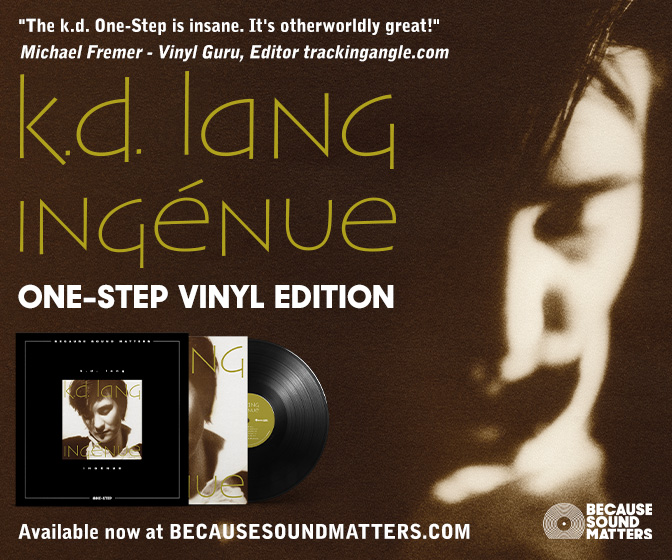Can Mobile Fidelity Still Cut It?
Mo-Fi's Anadisc 200 Return—What We Were Thinking in 1994
After making an impressive musical and sonic splash at last winterʼs C.E.S. (1994) with the superlative 200 gram vinyl edition of Muddy Waters Folk Singer (MFSL 1-201) and three less inspired choices: (ELPʼs Tarkus [feh!], Manhattan Transferʼs Extensions [yawn!] and Pink Floydʼs Atom Heart Mother [snooze]), Mobile Fidelityʼs vinyl reissue program sort of dribbled to a stop. In fact, the Pink Floyd didnʼt appear at the show due to a problem MoFi wouldnʼt identify.
The thick pressings, while very good, (though variable from sample to sample) lacked the silence, and physical polish of the JVC Japan pressed first series. When the Pink Floyd did show up, I found it sonically inferior to the gold CD in many ways, and my sample was noisy.
Then MoFi announced the reason for the release schedule hold up: it was buying the pressing plant it had contracted, and moving it up to Sebastapol so it could oversee production and QC. That was the good news. The bad news was the first new release: The Alan Parsons Projectʼs Tales Of Mystery and Imagination – Edgar Allan Poe (MFSL 1-204). Am I missing something? Is that what you want reissued on expensive vinyl? I donʼt.
MoFi then slipped us a few more reasonable choices: The MJQʼs Blues At Carnegie Hall (MFSL 1-206), Trafficʼs The Low Spark Of High Heeled Boys (MFSL 1-209) and the justifiably popular Getz/ Gilberto – all three of which had previously been released on gold CD by MoFi.
Then came news of the Hiatt release – an outstanding choice – the first really worthwhile vinyl reissue in my opinion since the Muddy. To balance it out: Jean Michel Jarreʼs pretentious electro-wank Oxygene. What next? A two LP set of Yanni Live At The Acropolis?
The LPs have arrived, and the news is indeed good. Physically and sonically these 200 gram vinyl releases indicate that MoFi is back in the groove and better than ever.
If you are like the cynical TAS staffer who recently confided to me, “I wouldnʼt put a Mobile Fidelity record on my turntable, much less play it”, these new releases will change your mind. Either that or your mind is closed. If I could ascribe any overriding sonic character to the new MoFi vinyl it would be the companyʼs own advertising slogan: “The Sweet Sound Of Vinyl Is Back”. Call me a shill, but these records are incredibly sweet without sounding veiled, rolled
or cloying.
While MoFiʼs mastering during its first vinyl era was uneven – hey theyʼre human too – there were dozens of great sounding LPs (Sinatra box, Cooderʼs Jazz, Hotel California etc.) – and many of the ones which offended (cut too low, too bright, no bass, too much bass, etc.) were, in my opinion, too good for the turntables of the day (i.e.: Sticky Fingers, The Doors, Music From Big Pink). If youʼve upgraded your front end, try those titles now. Some others are still way too bright (or bass-heavy). That was then, etc…
After kicking around Epic, MCA and Geffen records with a half dozen or so promising but mixed message releases, John Hiatt finally put it all together with his 1987 A&M debut Bring The Family. Having licked a long running substance abuse problem, married, began raising a family and settling in Nashville to focus on songwriting, Hiatt found the right balance between rock and country, gruffness and sentimentality, drama and humor. A Louis Armstrong like playfulness emerged in his voice.
Someone – probably Hiatt or producer Chelew – got the brilliant idea of giving Hiatt the stability of a virtuosic backing band – his own The Attractions or The Rumour. Though they used their own names on this date, the group later recorded a less interesting, though enjoyable LP as Little Village.
As Ry Cooder, Jim Keltner, Nick Lowe and John Hiatt, they took their act to Ocean Way and with Larry Hirsch at the controls created this exciting document of a shadow figure finally stepping into the light as an artist and as a man. The songs of love, inspiration and redemption support the act of creation occurring before the microphone.
Hereʼs the original “Thing Called Love” covered by Bonnie Raitt, the almost overwhelming “Lipstick Sunset” – arguably Hiattʼs finest song, the inspirational “Have A Little Faith In Me”, the elegant “Learning How To Love You” and seven other steps in Hiattʼs recovery program.
The spacious recording allows you to easily follow every instrumental line. Given the lineup, to have laid it down any other way would have been a waste of talent. The sound of Ry Cooderʼs slide is particularly liquid and tubey and Keltnerʼs kit has outstanding focus and transient snap.
As between the original Doug Sax mastered LP and this MoFi its no contest. The MoFi wins on most every count. Listen to the open spaciousness of “Lipstick Sunset” on the MoFi and the hard congestion on top of the original. Listen to the skin sound of the extra tom Keltner plays on the right channel. Pay particular attention to Hiattʼs voice and the tonality and positioning of the reverb chamber behind it. On the MoFi its way back in a separate space and airy. On the original its mixed into the voice and glarey. The only area the original excels is midbass warmth, but the MoFi has much tighter bass overall.
MoFi LP versus CD ? The CD is good, very good, but it’s a computer memory compared to the LP. What happened to Cooderʼs liquid, tubey slide? Gone. That tom on the right channel? Covered in gauze. The reverb behind Hiattʼs voice? Swamps him. Ocean Way? Might as well have recorded in a big closet.
The Sebastapol pressing is right up there with RTIʼs best in terms of “fit and finish” and quiet, though my copy is pressed slightly off center. Overall MoFiʼs Bring The Family is a superb reissue. It belongs on your record shelf.
Next to hormones, the Getz/Gilberto album was the second greatest make-out aide any high school or college kid in 1963/64 could ask for. The sensuous samba rhythm, Astrud Gilbertoʼs breathy voice, her husbandʼs soothing, intimate croakings in a strange though clearly enunciated language, and Stan Getzʼ lyrical, open tone – the whole package exuded a sophistication that killed guilt instantly.
But more importantly, the brilliant recording by Phil Ramone documents Getzʼs exquisite tone better than any other I can think of, save perhaps the record that started the whole Boss Nova thing: Jazz Samba (Verve V6-8432) wherein Stan Getz introduced mainstream America to modern Brazilian music.
Arriving as it did at a time when jazz had heated up to the improvisational breaking point – Colemanʼs “free jazz”, Cecil Taylorʼs piano extravaganzas and Coltraneʼs furious blasts of anger and religious passion, and as the “British Invasion” was signaling a new wave of rock and roll, Getzʼs melodic Brazilian import was wildly successful much as Paul Simonʼs South African venture was twenty two years later.
So, millions of copies of Getz/Gilberto were pressed. Original covers had white borders around the black, later ones lost the border. All were mass produced product, and pressing quality was wildly variable. I own my original copy bought the week it was released, plus a few later examples, and while their warm and fuzzy feel has atmosphere, MoFiʼs reissue is a vast improvement all around – particularly in its wide-open spaciousness.
Milton Bananaʼs high hat cymbal work is much cleaner and sharper and placed back in space behind the left speaker. Getzʼs tenor is airier and more liquid, Antonio Carlos Jobimʼs piano has more of the percussive quality of the real thing while losing none of the woody warmth of the instrument. Gilbertoʼs guitar has better defined body and ideal string tone and transients.
Make no mistake: this 30 IPS recording is an audiophile delight timbrally, though the wide staging typical of the era is somewhat unnatural. And while the music is easy to listen to, it is anything but easy listening. A classic reborn. If you own a turntable donʼt pass this up. If youʼre digital, MoFiʼs gold CD (UDCD 607) is a reasonable computer model but the vinyl is the real thing – I know MoFi Prez Herb Belkin would agree.
Oh, as for the best make-out aid in 1963/64? It was another record in this series: Antonio Carlos Jobim, The Composer Of Desafinado Plays (Verve V6-8547) – another spectacular Phil Ramone job in which the late Jobim plays guitar and one note piano versions of his classic compositions (“The Girl From Ipanema”, “Corcovado”, “One Note Samba:, “Desafinado”, “Chega De Saudade” etc.) backed by Claus Ogermanʼs lush string drenched orchestrations. This one really veers toward easy listening in the pejorative sense of the word, but it really, really works ! At least it did in 1964.
While weʼre on the subject: There was a series of Verve Boss Nova albums with abstract art covers by Olga Albizu including Getz/Gilberto and Jazz Samba. Another worth looking for is Big Band Bossa Nova featuring Stan Getz and The Gary McFarland Orchestra (Verve V6-8494) which features sophisticated arrangements by McFarland and players like Jim Hall, Doc Severinsen, and Clark Terry.
The Low Spark Of High Heeled Boys gold CD is very good, but this record is much, much better, spatially and harmonically, with far superior retrieval of inner detail, much better transient attack, and greater image dimensionality. Winwoodʼs best vocal recording is even more convincing on LP than CD and youʼll easily be able to hear the partially erased original vocal track to the title tune.
As with the CD, the fade-in on that track comes up out of complete silence and builds to a – well nothing here builds to much but well executed ear candy jamminʼ. When it sounds this good, who cares if it doesnʼt mean anything? A great recording mastered and pressed to perfection – better than the original British Island and the Japanese issue that I thought was as good as it could get. MoFiʼs got Sony to open its vaults again: the last time around we got Miles Davisʼ suave Some Day My Prince Will Come (MoFi MFSL 1-177,
Columbia CS 8456). This time we get a curious, but significant choice: Duke Ellingtonʼs soundtrack to Otto Premingerʼs Anatomy Of A Murder.
Jazz scores were in vogue both in the movies and on television when this was released in 1959: some films used already recorded material, some original. Benny Carter, The MJQʼs John Lewis, and Ellington are among the jazz musicians who contributed, along with career soundtrack composers like Elmer Bernstein (The Man With The Golden Arm) and Alex North (A Streetcar Named Desire).
If youʼve never heard a “6 eye” stereo Duke Columbia, hereʼs an easy way to hear what the fuss is all about – only better. If I was picking from the Dukeʼs big band Columbia catalogue Iʼm not sure this would be the one Iʼd choose first, but I donʼt know how the deal with Sony was struck.
Musically, this is a genuine soundtrack, long on texture and atmosphere, short on tunes. Much of the musical goings on are evocative of action: lurking woodwinds and dark brass motifs suggest alley way shadow figures, horn bursts announce play-by-play fight scenes, squealing muted trumpets and curling clarinets conjure up images of come hither eye rolls and fish net stockings on long legged women.
It is unclear whether this score was written to picture, and no studio is credited, so Iʼll guess Duke and company stayed in New York and recorded at Columbiaʼs spacious old 30th street studio. Wherever the track was laid down, it’s in a cavernous space, with the clusters of instruments placed far enough from the mikes to create the sensation of a great deal of distance between you and the orchestra, which is spread Cinerama style across a wide and deep stage – so much so, the sense of ensemble gives way to islands of instruments.
Compared to a fine sounding white label promo “6 eye”, the reissue offers better instrumental focus, on a wider, deeper, airier stage, more extended frequency response without sounding hard or brittle, superior transparency and dynamics, more convincing piano sound, and better bite to the brass.
Fine playing by the orchestra and spotlighted solos from Ellington regulars Johnny Hodges, Ray Nance and Paul Gonzalves make this an enjoyable, if not essential album.
At the Winter CES, MoFiʼs entire stock of Anatomy Of A Murder was sold out in hours, leaving piles of ELP, Manhattan Transfer, Alan Parsons etc. to gather dust. So MoFi, do you get the picture yet? Now please: Dukeʼs Piano In the Background, Piano In The Foreground, Blues In Orbit, Jazz Party In Stereo, etc.
Do you need another version of “Take Five” if you already own the original on the Columbia “6 eye” version of Time Out (CS 8192)? or the fine gold CD from Sony Legacy (CK52860)? No – even though Paul Desmond teams up with Brubeck yet again on Weʼre All Together Again For The First Time. While drummer Alan Dawson does a fine job with his drum solo on the classic tune, the version doesnʼt compare to the original musically or sonically. Even Gerry Mulligan on baritone sax doesnʼt save this compilation, recorded in Europe in 1972, from Brubeckʼs incessant pounding. Musically unimportant, sonically not so hot, this is, in my opinion, a waste of good vinyl, so save your money.
The MJQʼs Blues At Carnegie Hall is not the best MJQ album on Atlantic, musically or sonically, but it is worth owning, and this vinyl release really improves on the already fine gold CD MoFi issued a while back. Everything sounds less electronic and more acoustic on wax.
While the Carnegie Hall setting contributes to the warm, natural dynamic instrumental sound, the close miking and hard left/right mix create a totally unnatural soundstage, with Milt Jacksonʼs vibes and Connie Kayʼs drums way right and John Lewisʼ piano and Percy Heathʼs bass far left. Center space is occupied only by hall ambiance and one of Kayʼs cymbals.
The concert was a benefit for the Manhattan School of Music, but judging by the tentative, sometimes ill-timed applause, this was an audience of wealthy benefactors, not necessarily music lovers. Three of the MJQʼs best known works are included: “Pyramid”, “The Cylinder” and “Bagʼs Groove”. I wish MoFi had released MJQʼs European Concert, a Scandinavian recording from 1960 (Atlantic SD 2-603) instead. It has it all: great performances, and an outstanding mid-hall soundstage. Still if youʼre unfamiliar with the button down jazz of MJQ, Blues At Carnegie Hall ainʼt a half bad place to start. For one thing, the blues set really swings.
From the sublime to the ridiculous: like masturbation, listening to the Moody Blues is an activity best done alone. With another living breathing entity in the room, the portentous “poetry” that begins Moody albums is damned embarrassing, and what comes after only somewhat less so.
How does “impassioned lovers wrestle as one, senior citizens wish they were young” grab you? By the balls? How about “There you go man, keep as cool as you can. Face piles And piles of trials With smiles (ad nauseum)…”.
Okay, I admit it, I do it. Listen to the Moody Blues that is, oh hell, and masturbate too, though not at the same time – well not since 1970 anyway. The Yannis of rock music are a pretentious lot, and their continued popularity with the “rockinʼ” PBS crowd was predictable from the getgo.
What keeps me doing it, despite the sense of dirtiness and shame I feel afterwards (listening to the Moodys Iʼm talking about) is the groupʼs incredible production and recording quality. This is what separates nerdy audiophiles from normal music lovers, and I freely admit it. The sheer pleasure of “Deramic Sound” overcomes any revulsion at whatʼs sounding.
You wonʼt find better Moody sound than on British Deram originals mastered and pressed by Decca, and that includes On the Threshold of a Dream, though this MoFi vinyl is almost as good, falling short in only one respect: while the original offers crystalline, skyʼs the limit high frequency extension the MoFi is somewhat soft and slightly unfocused. But thatʼs just by way of comparison. On its own, it’s a brilliant sounding issue, once again more spacious and detailed than the fine sounding gold CD MoFi recently issued. I havenʼt auditioned the out of print Nautilus half-speed but I canʼt believe it’s better than either the original or the new MoFi. So if “Dear Diarrhea” – er “Diary”, “Share Our Love” and “Send Me No Wine” is your cup of jizz, knock yourself up – er out.
The day Freddie Mercury died, the phone rang and a voice went “dum dum dum dedum another one bites the dust”. It was my ex-girlfriend. Both of us were sure our mutual friend who also died of AIDS would have laughed: he had a wicked sense of humor, so we didnʼt feel too guilty at having a laugh at Freddieʼs expense. If youʼre offended, tell your friends.
From the first notes of the first album, at least Queen had a personality even if it was wimpy and mincing as it had to be, keying off of Freddie Mercuryʼs theatrical esthetic. Thatʼs more than you can say about many bands. Brian May – a trained astronomer by the way – built his own guitar and it certainly had a unique sound as did his playing and arranging.
Queen never really rocked no matter how hard it tried; campy pretense followed it around like a can tied to a dogʼs tail. The band was precious like a Keene print and equally artful, and why red blooded macho males were devotees always escaped me.
Freddie Mercuryʼs narcissistic stage prancing was always difficult to watch, but he was outrageous and a real audience pleaser. I suspect had Mercury lived, heʼd have abandoned rock for an Andrew Lloyd Weber type career – but with melodies.
Somehow, despite itself, Queen came up with some classics including “Bohemian Rhapsody”, and “We Will Rock You” (which they didnʼt), and if you can name the others, you might want The Game, an end of the seventies record which documents an unfortunate period every group endures: after phenomenal success, the members demand to assert their individuality.
How do you know when this is? One sure sign is when the drummer gets a song. Here both the drummer Roger Taylor and the bass player John Deacon get two apiece. Queen lucked out: Deaconʼs “Another One Bites the Dust” was a hit. The Game features an uneven mix of tunes, stylistically all over the map. Not a high point in the groupʼs long recording career.
The CD is clean, orderly and antiseptic, and very good as CDs go, but the record makes a rock and roll statement the CD canʼt: its big, brash and spacious in a way CDs ainʼt. Mayʼs guitar has much more bite, and instrumental focus and placement is much more precise. The recording by Euro/disco maven Mack lacks the elegance and harmonic richness of earlier Trident studio recordings, but it’s still pretty good.
Cream, Cream, Cream, Winwood, Winwood, Winwood. Allman Bros. Allman Bros. Allman Bros. MoFi sure knows how to mine a rut. At least here it’s a good rut. First Duane went to that big motorcycle testing grounds in the sky, then Berry Oakley sped off and joined him. At that point the smart money wrote the Allman Brothers Band off.
But Gregg and co. fooled everyone with the melodic, hook filled, Brothers and Sisters, released in 1973. The tragedies surrounding the band knocked the wind out of them, but instead of breaking up, they caught their collective breath and came back focused and almost sunny. “Wasted Words”, “Ramblinʼ Man”, “Southbound” and “Jessica” are all staples of “classic rock” FM radio, and deservedly so.
This was a well recorded album (though not an audiophile spectacular), featuring natural sounding instruments on a nicely rendered artificial soundstage. There isnʼt a hint of edge, grain or glare. If anything, the sound is warm and somewhat closed in, but Butch Trucksʼ and Jaimoeʼs drum kits crackle sweetly and Dicky Bettʼs slide guitar has plenty of body. Gregg Allmanʼs voice looms larger than life in the proceedings. I compared MoFiʼs new pressing to an original Capricorn white label promo copy mastered by George Marino, then at the Record Plant and it was close, with the MoFi having better focus and a far more extended and detailed top end. Bass on the MoFi was better articulated but somewhat anemic compared to the original pressing. The gold CD version is one of MoFiʼs better transfers. Chuck Leavellʼs piano is particularly well rendered on CD, but transients on the guitars are still softened, and cymbals have that thin digital thing happening compared to the meaty sounding vinyl.
Do you know what a Fender Telecaster sounds like? Have you ever heard one live at a blues club? Better yet have you ever heard the late Albert Collins live? If so, even if not, youʼve got to get both the LP and CD versions of Showdown! That way you can “A/B” the LP and CD for your digital loving friends – or for yourself.
The CD, though very good, cannot begin to capture the rich, bright complex harmonic structure of a Telecaster blasting away, nor its attack, as Collins rips into the strings. The LP will have you gritting your teeth with pleasure; the saliva pouring from your glands. The CD? Crank it up and it shuts you down. It just canʼt deliver the goods. You keep turning it up in a vain effort to get that slashing attack, but no can do.
This 1985 Alligator original featuring guitar greats Collins, Robert Cray and Johnny Copeland is a must have recording, one that was hard to listen to in its original vinyl configuration. The Alligator version was teeth rattling bright, hard and brittle. You had to listen through the grit to get to the goods.
Here, on either CD or LP you get one of the great contemporary blues guitar records (1985) and you can listen beyond the lead guitar to the foundation that was formerly frozen in the glaze.
Iʼm not going to go on about this record because along with the copious original notes, MoFi has gone back and gotten producer and Alligator owner Bruce Iglauer to write a detailed account of the circumstances that lead to the four day session and the goings on in and out of the studio. If the lineup on this disk isnʼt enough to get you to buy it, nothing I write will. One of MoFiʼs more inspired choices and an outstanding mastering job that makes a hard to listen to original enjoyable – if not audiophile quality. More choices like this MoFi!
So, can MoFi still cut it? Absolutely. Their new “Gain System” LP mastering chain designed by Nelson Pass, is sweeter, more detailed, and far less electronic sounding than the old one. The bright, thin brittle sound of some original MoFi LPs is gone. Iʼm still not sure half-speed mastering gets the bass right though.
As for the gold CDs, MoFiʼs chain, and the way it’s being used is resulting in consistently excellent sounding CDs, with far greater harmonic richness, spatial delineation, inner detail, and ambiance retrieval than they previously delivered. I just hope the company will be a little more creative and adventurous with its remastering choices in the future.









































